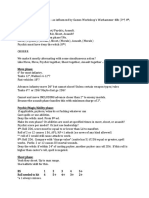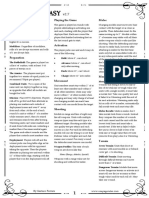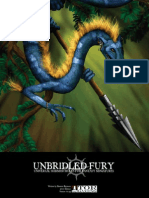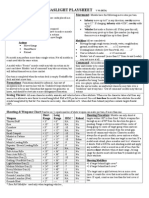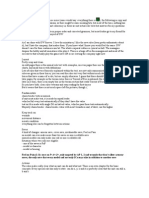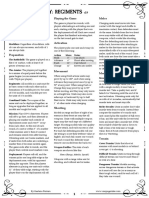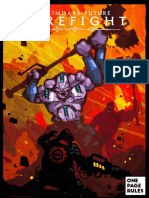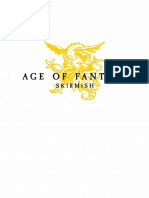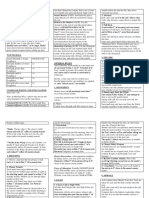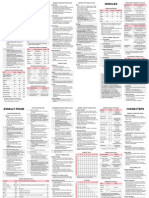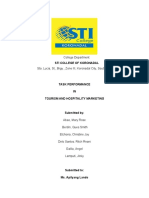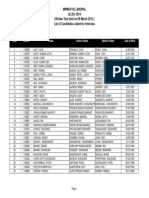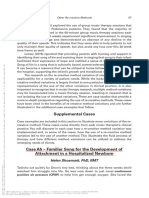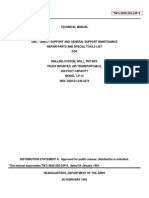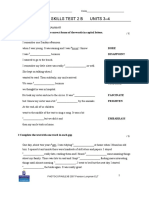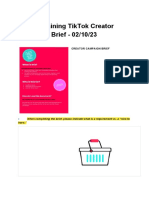Basic Rules, Tabletop Wargame with Alternating Activations
1. Initiative Phase
• Both players roll a die at the beginning of each battle round.
• The player with the highest roll has the initiative and activates a model first.
2. Orders Phase
• Issue Orders: Players secretly choose one order for each unit and place the order marker face
down next to the unit's Commander. Reveal orders simultaneously.
• Orders Include:
• Maneuver: The unit may perform a Normal Move, Advance Move (up to M+D6"), or Fall
Back Move, followed by a Shooting Action if it did not Advance. Cannot Charge.
• Hold and Fire: The unit may perform a Shooting Action with a bonus to hit. Cannot
Move or Charge.
• Storm: The unit may perform a Normal Move, followed by a Charge Action. Cannot
perform a Shooting Action.
• Defend: The unit gains a bonus to defense and may perform a Shooting Action but
cannot Move or Charge.
• Special Action: The unit may perform a Special Action, such as healing, repairing, or
deploying equipment.
• No Orders/Free Actions: If no order is issued, the unit may perform a Normal Move and
Shooting Action but without any bonuses.
3. Action Phase
Movement Action
• Normal Move: Models move up to their Move (M) characteristic. Cannot move within
Engagement Range of any enemy models.
• Advance Move: Models move up to M+D6". Cannot move within Engagement Range of any
enemy models. Models that Advance cannot shoot or charge this turn.
• Fall Back Move: Specific rules for retreating from combat.
Shooting Action
• Attack Declaration: Declare all attacks before resolving.
• Line of Sight and Range: Consider factors like range, target movement, terrain.
• To-Hit Roll: Roll 2D6 and apply modifiers to determine if the attack hits.
• Weapon Types and Special Effects: Consider special effects like Cluster, Pulse, or Rapid-Fire.
� • Damage Resolution: Roll for hit location, mark off armor, transfer damage if needed.
• Damage Transfer and Effects: Apply specific effects like Torso Destruction.
• Recording Damage: Use record sheets to track damage.
Charge Action
• Select Eligible Unit: A unit is eligible to charge if it is within 12" of one or more enemy units at
the start of your Charge phase, unless it Advanced or Fell Back this turn, is within Engagement
Range of any enemy models, or is an Aircraft unit.
• Select Targets: Choose the target(s) of the charge.
• Make Charge Roll: Roll 2D6 and add the result to the charging unit's Move characteristic to
determine the charge distance.
• Make Charge Move: Move the charging unit into Engagement Range with the target(s).
• Attack Declaration: Declare all attacks before resolving.
• To-Hit Roll: Roll 2D6 and apply modifiers to determine if the attack hits.
• Weapon Types and Special Effects: Consider special effects like Cluster, Pulse, or Rapid-Fire.
• Damage Resolution: Roll for hit location, mark off armor, transfer damage if needed.
• Damage Transfer and Effects: Apply specific effects like Torso Destruction.
• Recording Damage: Use record sheets to track damage.\
4. Damage Phase
Damage Resolution
Damage from attacks is always added to a record sheet after all players have activated all their units and
resolved actions.
• Applying Damage: To apply damage from an attack, follow these specific steps:
1. Determine Damage Inflicted: Identify the amount of damage inflicted and the hit
location based on the attack's characteristics and effects.
2. Attempt Invulnerable Save (if applicable): If the target model has an invulnerable save,
the controlling player may attempt it. Follow the rules for invulnerable saves, including
any modifiers. If successful, the attack sequence ends, and no damage is applied.
3. Allocate Damage: Distribute the damage to the appropriate location on the target
model, considering any special rules or conditions that may apply.
4. Transfer Excess Damage: If a location is destroyed and excess damage remains, follow
the rules for transferring damage to adjacent locations.
� 5. Apply Special Conditions: Implement any special conditions or effects resulting from the
damage, such as reduced movement or abilities.
6. Record Damage: Mark the damage on the target model's record sheet, and apply any
immediate effects or consequences.
• Special Conditions: Specific rules for conditions like leg destruction, which affects movement
and abilities.
Transferring Damage
• Units Survival: Units can survive the destruction of any section except vital areas like the head or
core. If a section is destroyed and the same location takes another hit, or excess damage
remains, that damage transfers to the armor of the next location inward.
• Damage Transfer Rules: Specific rules for transferring damage between sections, such as from
limbs to torso. Damage from destroyed vital areas does not transfer.
• Unit Destruction: A unit is considered destroyed if vital areas are destroyed. Destroyed units are
removed from the map at the end of the phase.
5. End Phase
• Players repeat all steps until one team meets its victory conditions or other end-game criteria
are met.
Conclusion
These rules provide a comprehensive framework for a dynamic and tactical tabletop wargame. The
Initiative, Orders, Action, Damage, and End Phases create a cohesive and engaging gameplay experience,
with detailed rules for movement, shooting, melee combat, orders, and more. The inclusion of
invulnerable saves adds a strategic layer, allowing players to manage damage to their units and make
critical decisions that can affect the outcome of the game.








